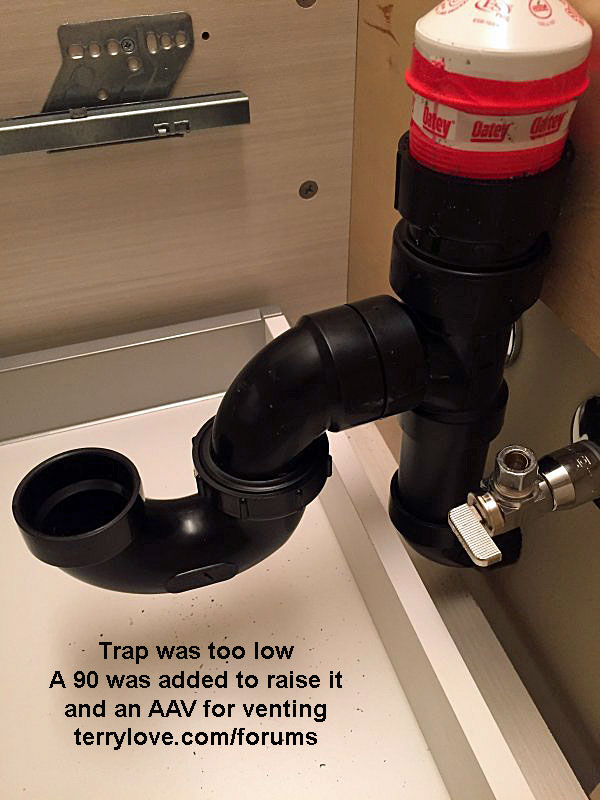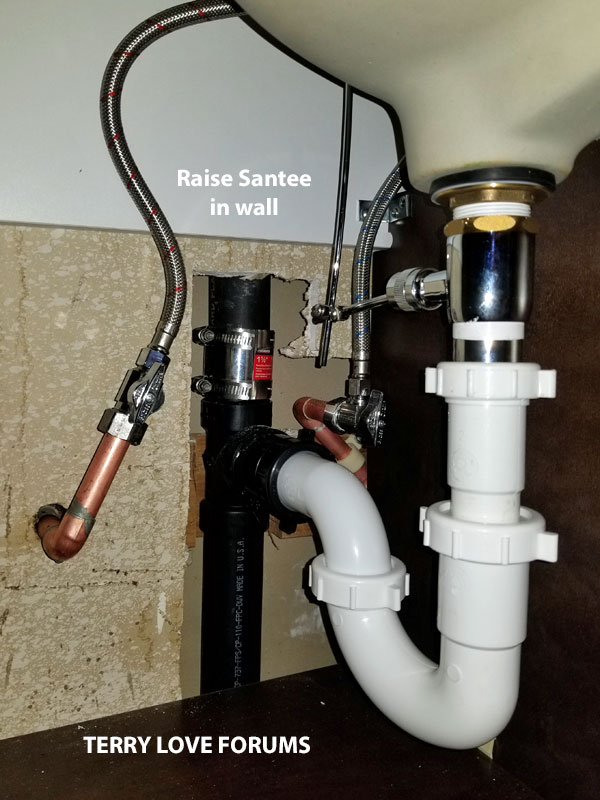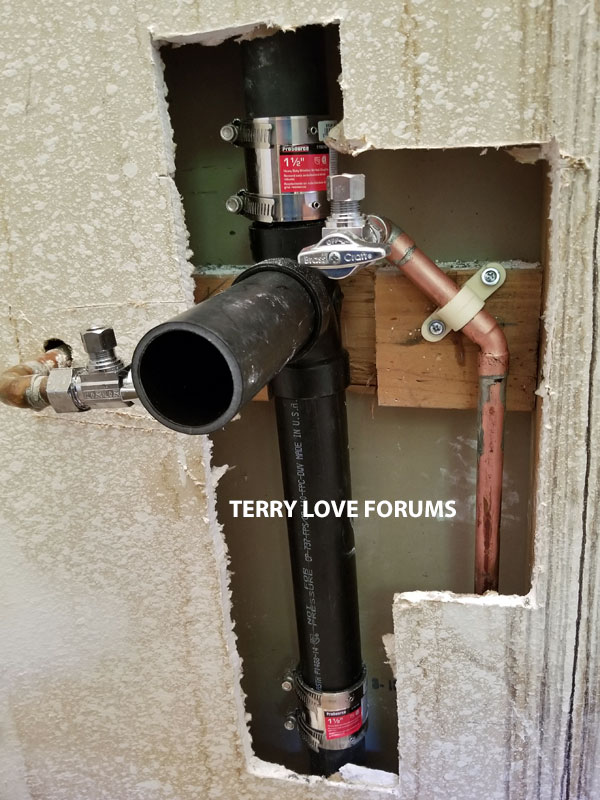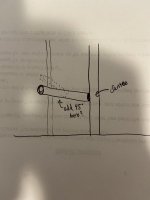As you can see in the picture, the drain and supply line plumbing for my new vanity is off by several inches. Any advice on what to do here? The PVC drain line is connected to the old cast iron line with a fernco fitting. I believe it’s currently sloped at 1/4” per foot. I’m worried if I raise it a few inches I could have some issues. Looking forward to any advice!
You are using an out of date browser. It may not display this or other websites correctly.
You should upgrade or use an alternative browser.
You should upgrade or use an alternative browser.
Vanity and plumbing offset for drain too low.
- Thread starter jbg_diy
- Start date
Users who are viewing this thread
Total: 2 (members: 0, guests: 2)
Hole saw comes to mind for the supply lines. Looks like you would want to do some cutting to let the drain line fit.As you can see in the picture, the drain and supply line plumbing for my new vanity is off by several inches. Any advice on what to do here? The pvc drain line is connected to the old cast iron line with a fernco fitting. I believe it’s currently sloped at 1/4” per foot. I’m worried if I raise it a few inches I could have some issues. Looking forward to any advice!
Alternatives: different vanity, or open the wall and move pipes. I am not a plumber. Vanity seller may let you swap units if this is a new unit.
Sponsor
Paid Advertisement
Old plumbing for a standard vanity, and now a new taller one with a drawer below?
This is the fix by adding more venting by way of an AAV.

This is the fix by adding more venting by way of an AAV.

Thanks Terry. My situation is slightly different in that the drain line is hitting the frame of the vanity. I could open the wall and raise it, but I’m worried I’ll have issues down the road with such an increased pitch. This does look like a great solution if I could somehow get it to work.Old plumbing for a standard vanity, and now a new taller one with a drawer below?
This is the fix by adding more venting by way of an AAV.

If the pipe in the wall is vertical, I go in and raise the santee using shielded couplings.




Last edited:
If the pipe in the wall is vertical, I go in and raise the santee using shielded couplings.
It’s actually running horizontal to the main drain/vent stack. I’d raise it but I’m concerned I’ll have issues down the road if the pitch is greater than 1/4” per foot, which it definitely will be. Would you be concerned as well about maintaining that pitch?


If your horizontal pipe is pitched more than 1/4 per foot, then you will need to add a vent.
This could be from a pipe attaching 6 inches or more above the flood level of the sink. If you are interested in doing that, good.
Houston, unlike most of Texas, is under UPC, and they may not allow AAV vents. I don't know.
Actually, if you are going to open a wall, you would be better off adding a new horizontal (1/4 in/ft) to a new sanitary tee. As easy, or maybe easier, than adding a vent pipe.
This could be from a pipe attaching 6 inches or more above the flood level of the sink. If you are interested in doing that, good.
Houston, unlike most of Texas, is under UPC, and they may not allow AAV vents. I don't know.
Actually, if you are going to open a wall, you would be better off adding a new horizontal (1/4 in/ft) to a new sanitary tee. As easy, or maybe easier, than adding a vent pipe.
If your horizontal pipe is pitched more than 1/4 per foot, then you will need to add a vent.
This could be from a pipe attaching 6 inches or more above the flood level of the sink. If you are interested in doing that, good.
Houston, unlike most of Texas, is under UPC, and they may not allow AAV vents. I don't know.
Actually, if you are going to open a wall, you would be better off adding a new horizontal (1/4 in/ft) to a new sanitary tee. As easy, or maybe easier, than adding a vent pipe.
Thanks for the info and advice. I was thinking of adding a new sanitary tee it’s just I’m dealing with a cast iron vent/drain stack
You mean other than a different vanity?Thanks for the info and advice. I was thinking of adding a new sanitary tee it’s just I’m dealing with a cast iron vent/drain stackany advice on the best way to add a new one to cast iron? Currently the pvc pipe you see is attached to the old cast iron drain with a fernco fitting.
If you cut the cast iron with a Diablo blade on a reciprocating saw, be careful to not stab through the wall on the other side. A shorter stroke can help with that.
Support the cast iron above before cutting.
If the new vanity will cover right against the wall that you open, it does not have to be as good of finish.
Edit: how about getting the vanity frame reinforced somehow, and cut away the frame portion that interferes with the current drain location.
Last edited:
wwhitney
In the Trades
Cut vanity legs to lower it?
Cheers, Wayne
Cheers, Wayne
Jeff H Young
In the Trades
the line being horizontal can still be offset without touching stack an aav can still be put on the trap arm. it can exceed 1/4 per foot have 45s what ever as long as he uses the aav
Thanks. Have definitely considered this and still considering this. Seems like the ideal option, but I also like the comfort height of 36”. Just trying to weigh my options at this point.Cut vanity legs to lower it?
Cheers, Wayne
I’m starting to think I should just cut the legs or get a new vanity, but it’s through Wayfair and they have the worst return policies. I appreciate the advice. I really wanted to see what my options were and ultimately make a decision soon.You mean other than a different vanity?
If you cut the cast iron with a Diablo blade on a reciprocating saw, be careful to not stab through the wall on the other side. A shorter stroke can help with that.
Support the cast iron above before cutting.
If the new vanity will cover right against the wall that you open, it does not have to be as good of finish.
Edit: how about getting the vanity frame reinforced somehow, and cut away the frame portion that interferes with the current drain location.
https://www.houstonpermittingcenter.org/help/codes
I don't find Houston allowing AAVs, but I could have missed it. ... if that matters to you.
I don't find Houston allowing AAVs, but I could have missed it. ... if that matters to you.
the line being horizontal can still be offset without touching stack an aav can still be put on the trap arm. it can exceed 1/4 per foot have 45s what ever as long as he uses the aav
Hi Jeff,
Very late reply, but are you saying if I put a 45 close to where the drain comes out of the wall to raise it I’ll still need an AAV on the trap arm? What if I used a 22.5?
Attachments
wwhitney
In the Trades
The basic rule to prevent trap siphoning is that the bottom of the pipe (the "invert") at the trap outlet has to be lower in elevation than the top of the downstream vent opening. If using a san-tee to vent, that would be the top of the side inlet on the san-tee, at the opening in the vertical run of the san-tee. (That's slightly lower than the inside of the top of the hub on the side inlet, I believe.)
So how high are you raising your trap? If it still satisfies the trap invert rule, the san-tee can be your vent. If you're raising up the trap invert higher than the top of the san-tee opening, you will need a different vent, which does meet the trap invert rule. Such as an AAV.
Cheers, Wayne
So how high are you raising your trap? If it still satisfies the trap invert rule, the san-tee can be your vent. If you're raising up the trap invert higher than the top of the san-tee opening, you will need a different vent, which does meet the trap invert rule. Such as an AAV.
Cheers, Wayne
Jeff H Young
In the Trades
if trap arm is offset with any fittings you will need aav
wwhitney
In the Trades
A good general rule for vertical offsets, although an offset in a 1-1/2" trap arm from a 22.5 plus street 22.5 would only be 11/16". So if the rest of the trap arm drop is only 1/2", it would still comply with the trap weir rule. Pretty much any other case of vertical offset would fail the trap weir rule and require an alternate vent like an AAV.if trap arm is offset with any fittings you will need aav
Cheers, Wayne
Jeff H Young
In the Trades
You may have a point wayne. so a typical 42 inc long trap arm normal would have 7/8 inch of fall. so you your figuring that 7/8 " offset might be acceptable code. Ill have to check code , I thought offsetting a trap arm was prohibitedA good general rule for vertical offsets, although an offset in a 1-1/2" trap arm from a 22.5 plus street 22.5 would only be 11/16". So if the rest of the trap arm drop is only 1/2", it would still comply with the trap weir rule. Pretty much any other case of vertical offset would fail the trap weir rule and require an alternate vent like an AAV.
Cheers, Wayne
I am skeptical that it would be allowed in IPC, and even more skeptical about UPC going for it.. Note that the max trap arm length in UPC is less, and I think they expect more open open air space.A good general rule for vertical offsets, although an offset in a 1-1/2" trap arm from a 22.5 plus street 22.5 would only be 11/16". So if the rest of the trap arm drop is only 1/2", it would still comply with the trap weir rule. Pretty much any other case of vertical offset would fail the trap weir rule and require an alternate vent like an AAV.
Similar threads
- Replies
- 0
- Views
- 147
- Replies
- 0
- Views
- 222
- Replies
- 3
- Views
- 255
- Replies
- 29
- Views
- 2K

